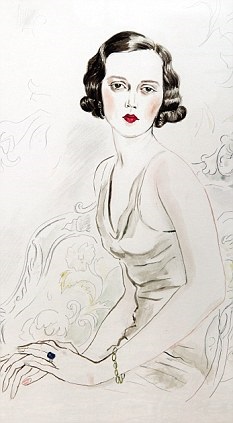www.spectator.co.uk/books/9125512/sheila-by-robert-wainwright-review/
THE
SPECTATOR
Australia's entrancing Sheila
Robert Wainwright's interesting biography of Sheila Chisholm traces her journey from grazier's daughter to wife of royalty and lover of Prince Albert
Selina Hastings 1 February 2014

Portrait of Sheila by Cecil Beaton
Sheila: The Australian Ingenue Who Bewitched British Society
Robert Wainwright
Allen and Unwin, pp.410, £14.99, ISBN: 9781743316825
The 'dollar princesses', those American heiresses who crossed the Atlantic in search of a titled husband, are familiar figures from the 19th and early 20th century. Less well known are the young ladies who made the much longer journey from Australia, and who, like their transatlantic counterparts, arrived in England with large fortunes, ready to be launched on an intensely competitive marriage market.
Sheila Chisholm was one of these arrivals from 'the Land of the Wattle', as the colony was often described. The daughter of a wealthy grazier from New South Wales, she reached London in July 1914 with barely enough time to be presented at court before the outbreak of war. Charming and beautiful, Sheila under more peaceful conditions would undoubtedly have enjoyed a successful season; instead, she and her mother left London for Cairo, where one of her brothers was stationed with an Australian cavalry regiment. It was here that Sheila met the first of her three husbands. Lord Loughborough was the son of the notorious Earl of Rosslyn, a compulsive gambler, later immortalised as 'the Man who Broke the Bank at Monte Carlo'.
'Loughie' was a pleasant fellow but hopelessly weak-willed, as Sheila discovered soon after the wedding. Like his father, he was addicted to gambling, and in addition was a lifelong alcoholic. Sheila bore him two sons and did her best to cope, but there was no reforming Loughie, so after a while she gave up, concentrating instead on a glamorous social life in the company of her best friend Freda Dudley Ward.
Freda was mistress of the Prince of Wales, and in no time at all a cosy quartet had formed, with the Prince and Freda as one couple, and his younger brother, Prince Albert ('Bertie'), paired off with Sheila. Referring to themselves as 'the Four Do's', they were frequently together, at restaurants and nightclubs as well as dinners in private houses. Edward was constantly being sent off on tours abroad, including to Australia, and relieved his boredom by writing long childish letters to 'Fredie darling' about how much he missed her and 'Shelie': 'What wonderful fun we Four Do's have, don't we angel and f*ck the rest of the world.'
It seems clear from the correspondence to which Robert Wainwright has had access that Bertie fell in love with Sheila, but that his father, appalled when he discovered his son was conducting an affair with a married woman, ordered him to put a stop to it at once. Miserably, Bertie obeyed, and was rewarded with the dukedom of York and a plump fiancée in the shape of Lady Elizabeth Bowes-Lyon.
Sheila, meanwhile, moved on to a lengthy affair with the glamorous Prince Serge Obolensky, and a rather more light-hearted relationship with Rudolph Valentino. After a romantic encounter in London, she saw the famous actor again while on a visit to Hollywood, where his girlfriend, Pola Negri, furiously jealous of the lovely Lady Loughborough, attacked him so violently that the injured star had to take to his bed for a week. Meanwhile Sheila's marriage to Loughie ended in divorce, and in 1928 she married again, her second husband, Sir John Milbanke, known for his prowess in the ring as 'the Boxing Baronet'.
His sporting achievements apart, 'Buffles' Milbanke seems to have been an unrewarding companion, choosing to spend most of his time drinking at White's, eventually dying as a result of a traffic accident shortly after the Second World War. Undeterred, Sheila opened a travel agency in Fortnum & Mason and took a third husband, Prince Dimitri Romanoff, with whom she lived happily until her death in 1969.
As social history Sheila Chisholm's life is fascinating, and the range of her acquaintance was unusually wide, from British royalty to writers such as Noel Coward, Nancy Mitford and Evelyn Waugh. Unfortunately many of these are barely mentioned, Nancy appearing unacknowledged in a photograph, Coward only occasionally crossing the stage, although the author rightly credits Sheila with telling Waugh about the cemetery in California which inspired his novel The Loved One.
Robert Wainwright has clearly conducted some extensive research but he relies too much on gossip columns; he quotes these at length (while failing to learn from them the correct use of titles), thus giving us a great deal of detail that glances over the surface but rarely penetrates beneath.
Nonetheless, Sheila Chisholm's story is well worth disinterring, and it's undeniably enjoyable to read of all that glitter and gold.
Available from the Spectator Bookshop, £13.49. Tel: 08430 600033

